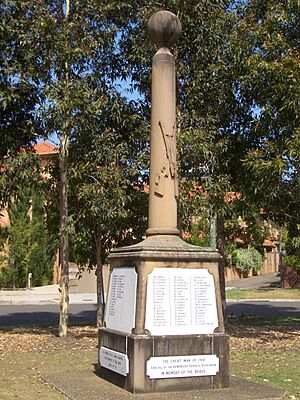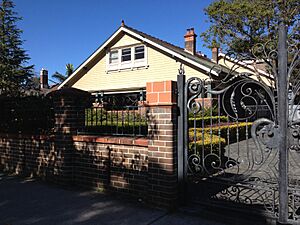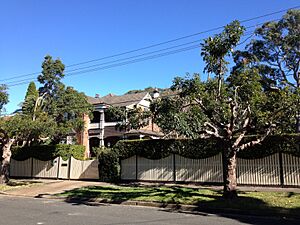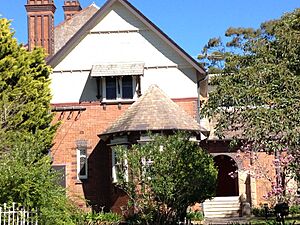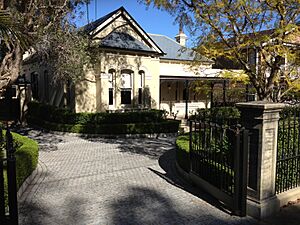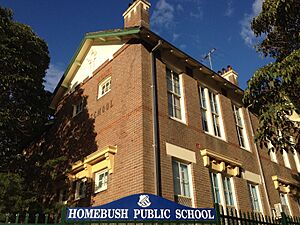Homebush, New South Wales facts for kids
Quick facts for kids HomebushSydney, New South Wales |
|||||||||||||||
|---|---|---|---|---|---|---|---|---|---|---|---|---|---|---|---|
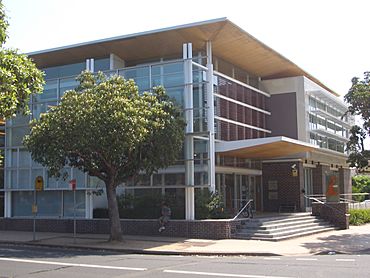
Library, Rochester Street
|
|||||||||||||||
| Population | 11,660 (2021 census) | ||||||||||||||
| • Density | 5,800/km2 (15,000/sq mi) | ||||||||||||||
| Postcode(s) | 2140 | ||||||||||||||
| Elevation | 143 m (469 ft) | ||||||||||||||
| Area | 2 km2 (0.8 sq mi) | ||||||||||||||
| Location | 12 km (7 mi) west of Sydney CBD | ||||||||||||||
| LGA(s) | Municipality of Strathfield | ||||||||||||||
| State electorate(s) | Strathfield Drummoyne |
||||||||||||||
| Federal Division(s) | Reid | ||||||||||||||
|
|||||||||||||||
Homebush is a suburb in the Inner West area of Sydney, New South Wales, Australia. It is about 12 kilometres west of the main city centre of Sydney. Homebush is part of the Municipality of Strathfield local government area.
The name "Homebush" comes from a large property called "Home Bush Estate." This estate was owned by an early colonial surgeon named D'Arcy Wentworth. The historic Homebush railway station, built in 1855, was named after this estate.
Today, Homebush is split into two main parts by the railway line, Parramatta Road, and the M4 Motorway. These two parts have different histories and uses. South of the railway is "Homebush South." This area has many older homes, a school, and a historic shopping street. Newer apartment buildings are also near the station. North of the railway is "North Homebush." This area used to be more industrial and residential. Now, it has many new high-rise apartments and businesses.
Some other places nearby also use the name "Homebush." For example, the suburb of Flemington was officially called "Homebush West" in 1992. Homebush Bay is a large water inlet on the Parramatta River. It is now surrounded by suburbs like Wentworth Point, Sydney Olympic Park, and Rhodes.
Contents
History of Homebush
The first European settlement in this area was called "Liberty Plains" in 1793. This was where the colony's first free settlers received land grants. Most of these settlers soon moved to other places with better farming land. One settler, Edward Powell, later returned and built the Half Way House Inn on Parramatta Road.
When the Great Western Railway line was built, a station was placed near Powell's Inn. This station was named "Homebush" after the large "Home Bush Estate" nearby. This estate belonged to D'Arcy Wentworth, a surgeon in the colony. Many people believe Wentworth named the area "Home Bush" because it was his "home in the bush."
However, some historians say that an earlier land owner, Thomas Laycock, actually named the property "Home Bush" in 1803. Wentworth later acquired the land from Laycock and kept the name. The original "Home Bush Estate" was much larger than the current suburb of Homebush. Most of it is now in Sydney Olympic Park and Flemington.
The current suburb of Homebush was mostly developed from a different property called "Underwood Estate." In 1878, the "Village of Homebush" was created from this estate. It was located south of the railway line. This village grew with homes and a small shopping street on Rochester Street.
After 1885, the area north of the railway became known as "Homebush." This part developed later. In 1906, it became its own local government area called "Homebush Municipality." This area grew quickly with new industries and homes. A cinema opened on Parramatta Road in 1925, helping the commercial area grow.
In 1947, Homebush Municipality joined with Strathfield Municipality. The current suburb boundaries of "Homebush" were set in 1995. They combine parts of the old "North Homebush" and the northern part of Strathfield.
What Homebush Looks Like Today
Homebush is made up of different areas that grew at different times. Its borders are generally Saleyards Creek to the west and Powells Creek to the north and east. To the south, it borders the suburb of Strathfield.
Homebush South (The Village)
Homebush South, also known as Homebush Village, is the part of Homebush located south of the railway line. About 2,800 people live here.
This area was first developed in 1878 as the "Village of Homebush." It was part of the larger Underwood Estate. Many large houses and villas were built here by the end of the 1800s. Today, many of these old homes are still standing and are protected as heritage areas.
The main shopping area of Homebush Village is on Rochester Street, close to the railway station. This street has many cafes, restaurants, and local shops. You can find a bakery, flower shop, newsagency, butcher, and more. These shops also extend to The Crescent, across from Homebush railway station.
While there are some apartment buildings near the village centre, most of Homebush South has freestanding houses. The western border of Homebush South is Saleyards Creek.
Homebush Public School, which opened in 1885, is in the village centre. Homebush Boys High School is on the western side of Homebush South. Strathfield Girls High School is nearby in Strathfield and also serves this area. The main library for Strathfield is also located on Rochester Street in Homebush South.
Homebush South is connected to North Homebush by two roads: Subway Lane, which goes under the railway, and Bridge Road, which goes over it.
Historic Houses in Homebush Village
Many beautiful old houses were built in Homebush Village. Some of these include:
- Billesdon: Built in 1915 for Stephen Rabone.
- Dunkeld (now Edensor): Designed by Joseph Alexander Kethel and built in 1906.
- Ingera: Built around 1894 for William Norton.
- Wellbeck (later Warwick): Built around 1892. It became known as Warwick when Emily Forrester, the widow of William Forrester from Warwick Farm, owned it.
North Homebush
North Homebush is the part of Homebush north of the railway line. It is split by Parramatta Road and the M4 Western Motorway. Most of its 8,900 residents live in the area between the M4 and the railway.
This area developed a bit later than Homebush South. In the 1870s, stockyards (where livestock were bought and sold) were built near the station. Hotels and businesses grew around these stockyards.
When the stockyards moved in 1883, North Homebush started to develop more. It became its own municipality in 1906. The area around Parramatta Road became a busy commercial hub. Factories like Arnott's Biscuits and EMI records were built nearby.
After World War II, traffic increased and many shops on Parramatta Road closed. Some old buildings remain, like the Horse and Jockey Hotel. This pub is on the site of the original Half Way House Inn. The large, old Homebush Cinema is also still there, though it is no longer used.
Today, many car dealerships are on Parramatta Road. However, this area is now being redeveloped with many new mid-rise and high-rise apartment buildings. The M4 motorway, built in the 1970s, caused some historic homes in North Homebush to be demolished.
North of the M4 motorway, there used to be industrial land. Now, it has been turned into parks, office buildings, and the DFO Homebush shopping centre.
There are no schools directly in North Homebush. Students here attend Homebush Public School or North Strathfield Public School. They also go to Homebush Boys High School and Strathfield Girls High School.
Heritage Sites
Homebush has several sites listed for their historical importance. One important state heritage-listed site is the Homebush railway station itself.
Local Government
Homebush South was one of the first areas to form the Strathfield Council in 1885. The part of Homebush north of the railway became its own local government, Homebush Municipality, in 1906. This municipality operated until 1947, when it joined with Strathfield Municipality.
At the state level, Homebush is represented in the Parliament of New South Wales by politicians from the Strathfield and Drummoyne areas. At the federal level, Homebush is part of the Division of Reid.
Getting Around Homebush
Homebush railway station is served by trains on the Inner West & Leppington Line of the Sydney Trains network. This means you can catch trains to many parts of Sydney from here.
Strathfield railway station is also close by. It offers express train services and connections to regional and intercity lines. North Strathfield railway station is also nearby for those in North Homebush. It is on the Northern Line. A new fast train line, Sydney Metro West, will also serve North Strathfield in the future.
Transit Systems buses also run through the area.
Parramatta Road and the M4 Motorway are the main roads that go through North Homebush. Homebush South can be reached by Homebush Road and Beresford and Broughton Roads. There are two ways to drive between North Homebush and Homebush South: the Bridge Road overpass and the Subway Lane underpass.
Schools in Homebush
- Homebush Public School is a government primary school. It opened in 1885 and is located between The Crescent, Rochester Street, and Burlington Road.
- Homebush Boys High School is a public high school for boys. It was founded in 1936. The school is known for its strong academic results. It has about 1200 students from many different backgrounds.
- The Catholic Seminary of the Good Shepherd, which trains priests, is also located in Homebush South.
People of Homebush
At the 2021 census, Homebush had 11,660 people. This is a big increase from 2016, showing how quickly North Homebush is growing.
About 27.9% of people were born in Australia. Other common birthplaces include India (19.7%), China (12.6%), South Korea (7.1%), and Nepal (5.9%).
The most common ancestries were Chinese (23.1%), Indian (16.5%), and English (9.1%). About 25.3% of people spoke only English at home. Other languages spoken include Mandarin (13.8%), Korean (8.1%), and Tamil (6.6%).
The most common religions were No Religion (30.3%), Hinduism (25.1%), and Catholic (14.8%). The average weekly household income in Homebush was $2,101, which is higher than the national average.
Famous People from Homebush
Many interesting people were born or have lived in Homebush, including:
- Patricia Carlon, a writer.
- Billy Hughes, a former Prime Minister of Australia.
- Thomas Keneally, a famous writer who wrote Homebush Boy: A Memoir.
- James McGirr, a former Premier of New South Wales.
- D'Arcy Wentworth, the colonial surgeon who owned the "Home Bush Estate."
Images for kids


